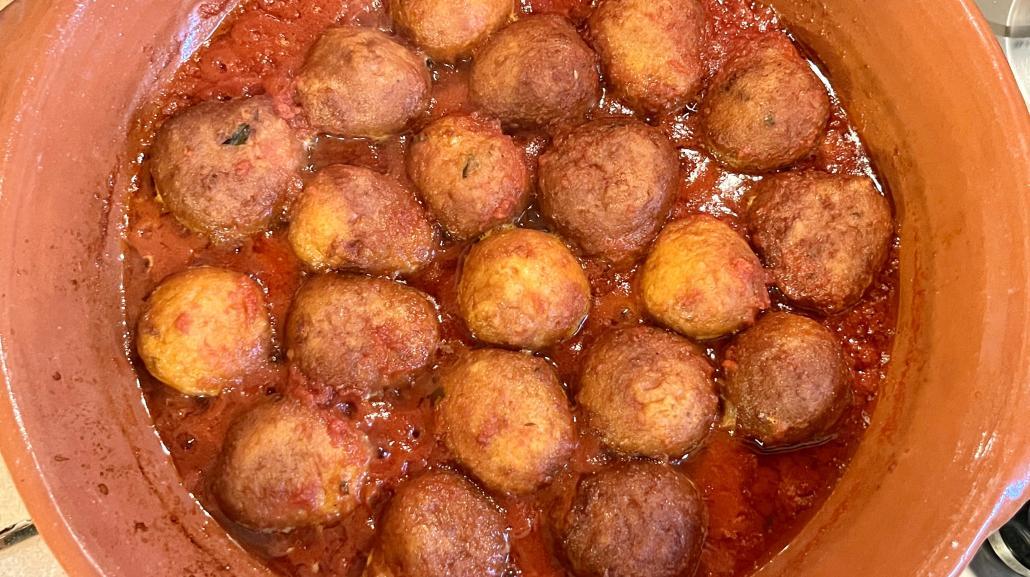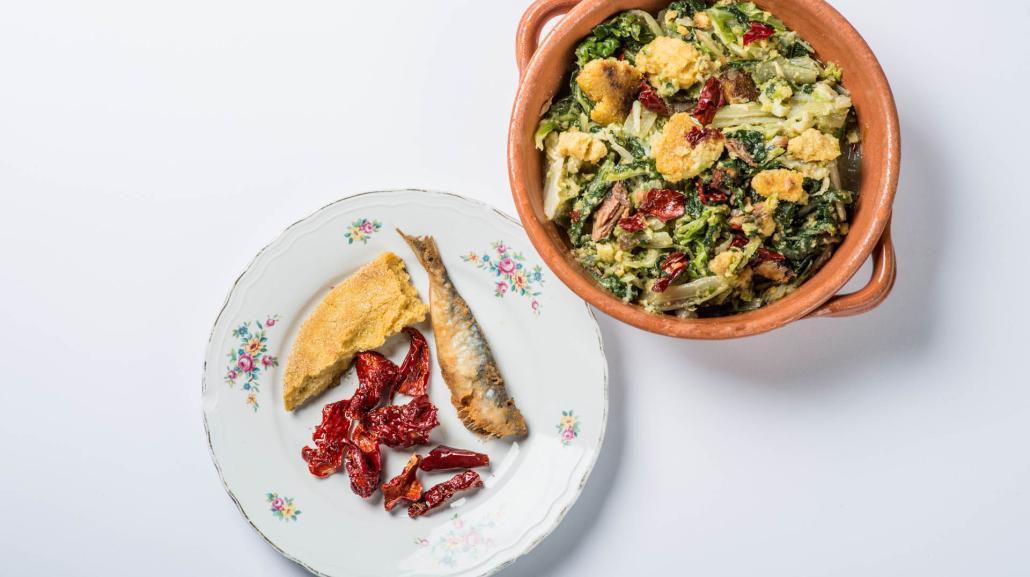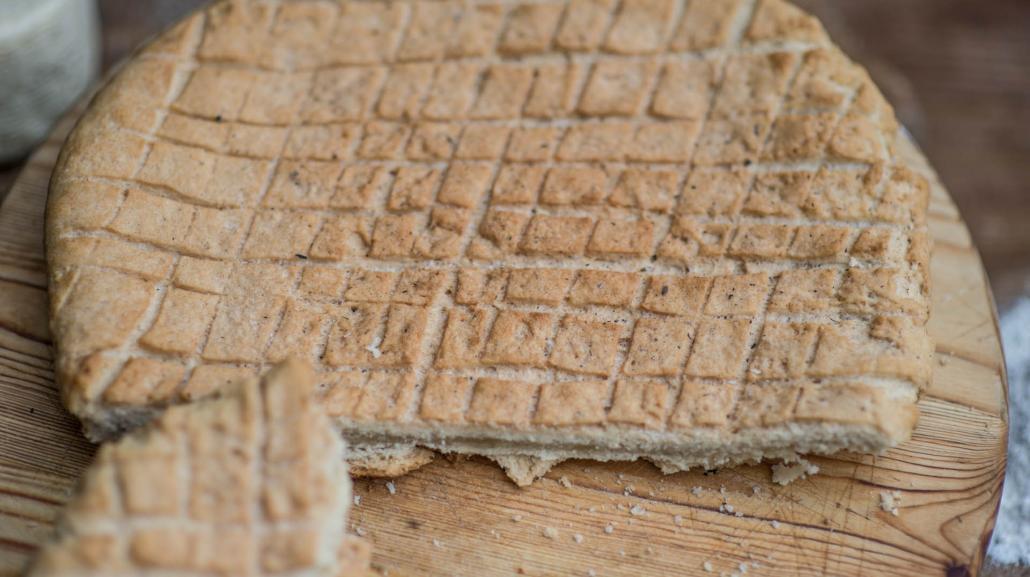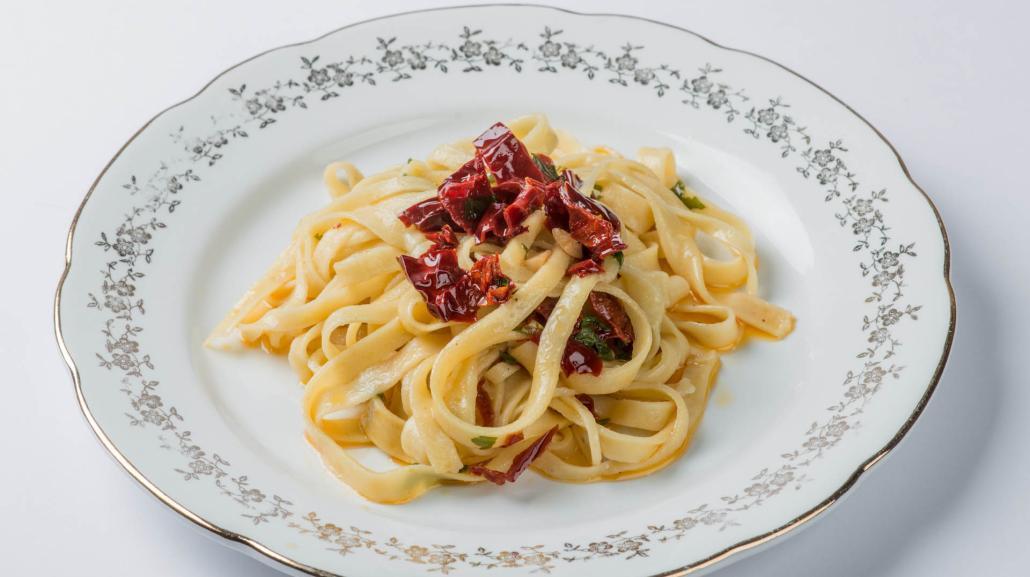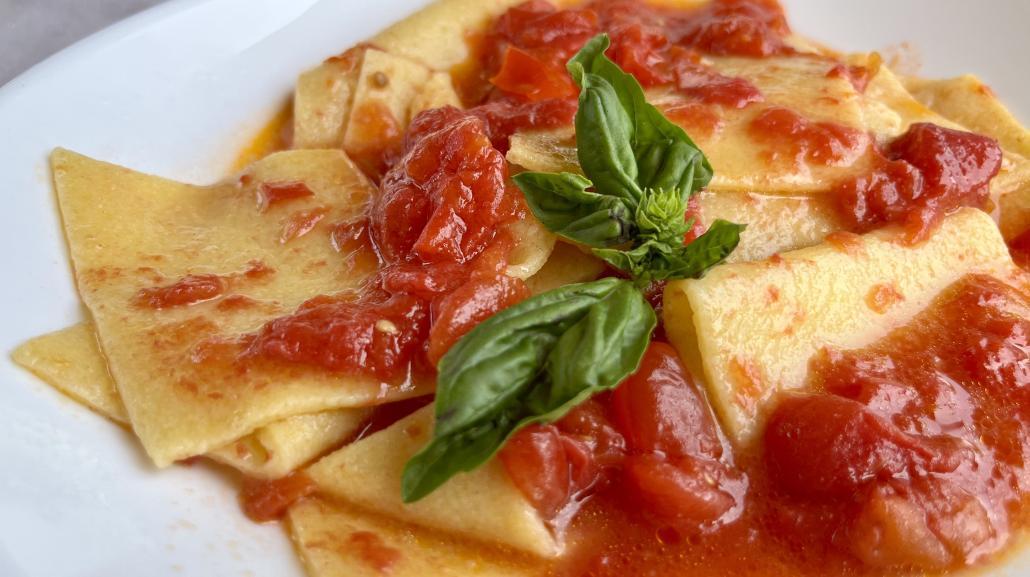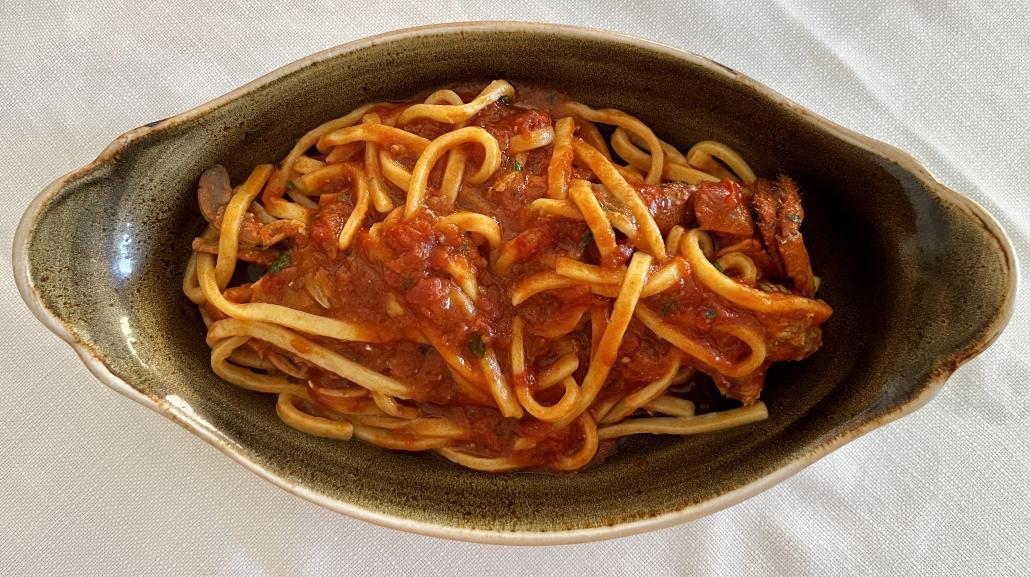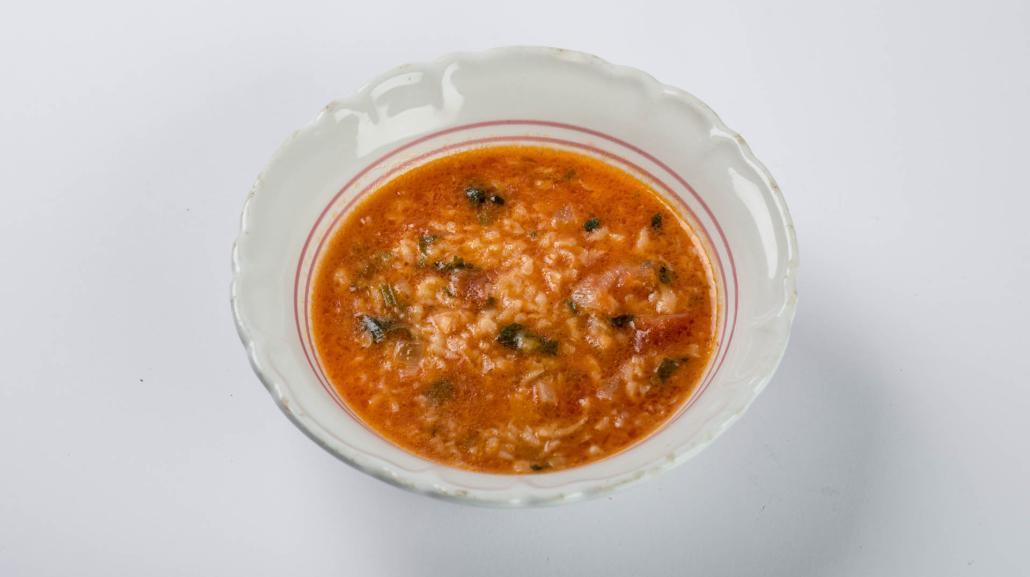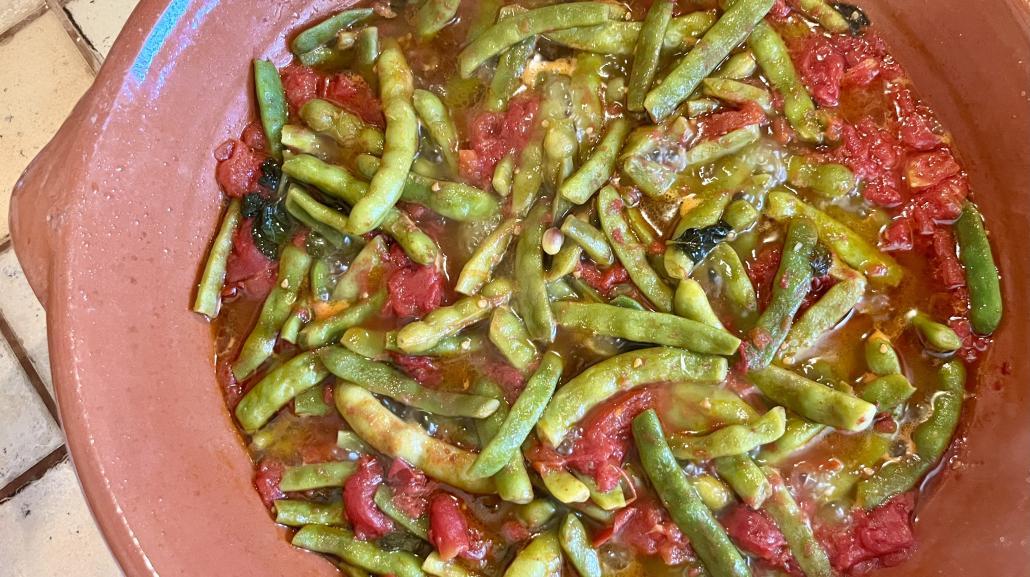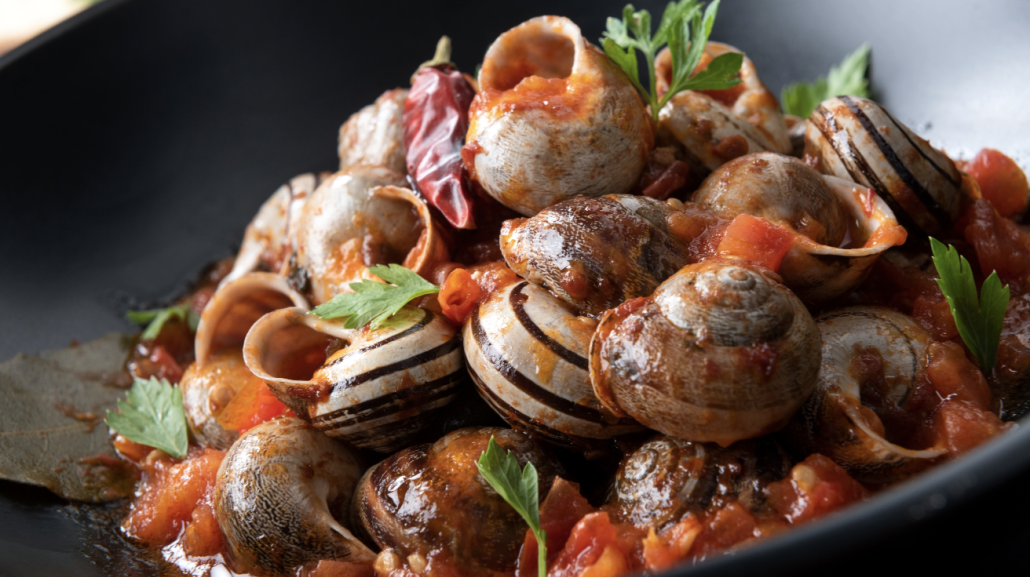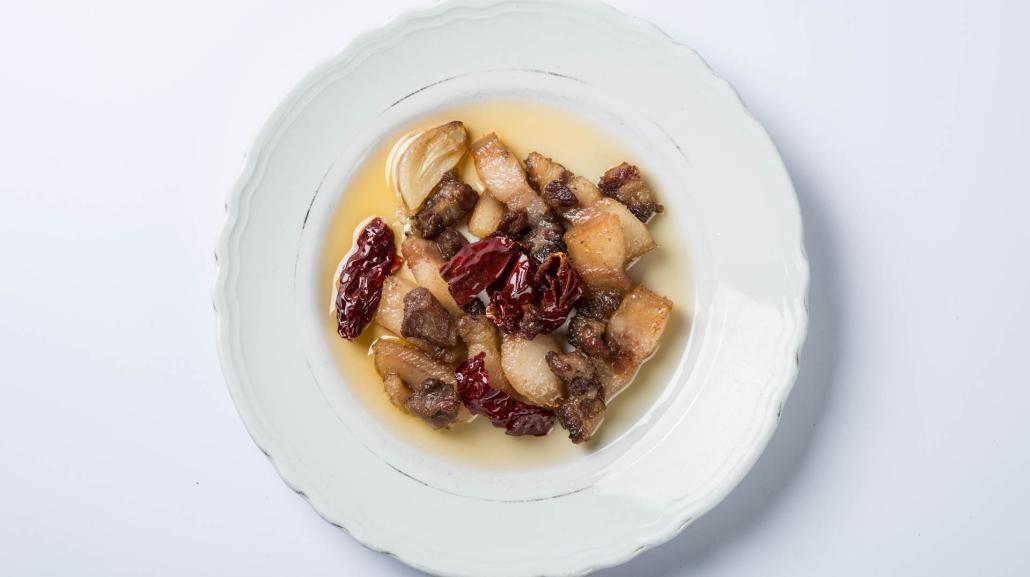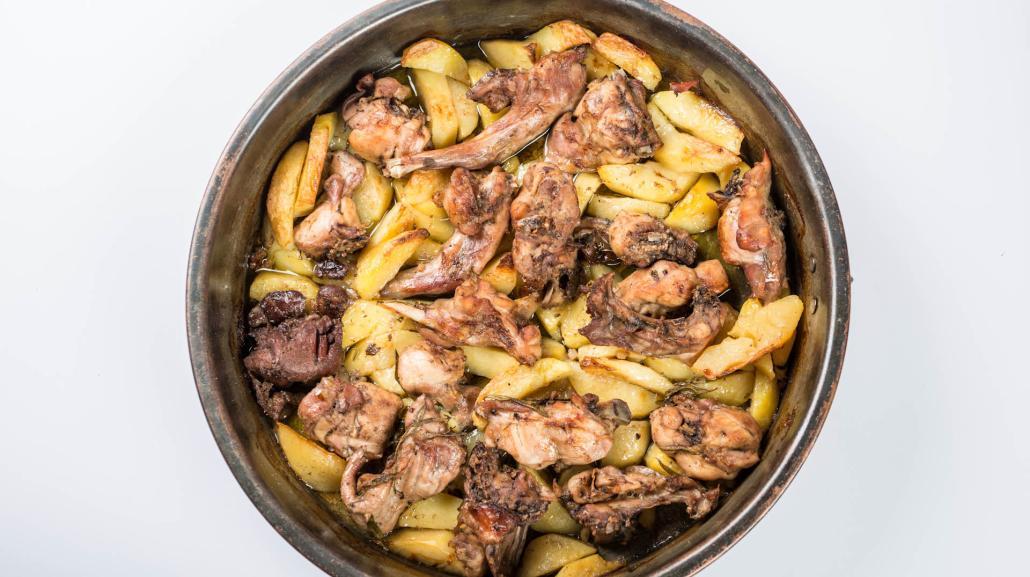A review of the main preparations • PALLOTTE CACIO E UOVA • PIZZ E FOJE • PIZZA SCIMA • MACCHERONI ALLA TRAPPITARA • SAGNE A PEZZE O TACCONI • RINTROCILO • FRASCARELLI • FAGIOLI SUOCERE E NUORE AL POMODORO FRESCO • CODFISH AND ITS MANY VARIATIONS • CIAMMAICHE AL SUGO • CIF E CIAF • THE FLAVORS OF THE COURTYARD: RABBIT UNDER THE COPPO, DUCK WITH SAUCE, AND SMOTHERED CHICKEN
A review of the main preparations
The Frentana Popular Cuisine has its roots in the agro-pastoral culture of the province of Chieti, an area that stretches from the eastern Majella, the mother mountain, to the Adriatic Sea. This cuisine is based on simple and genuine raw materials: in addition to olive oil and wine, there are grains, legumes, wild vegetables, preserved fish such as cod, poultry, and pork, which with its tasty meats and typical cured products, ensured an important reserve of meat throughout the year.
A heritage of preparations and shared knowledge linked to rural tradition, passed down from generation to generation, was at risk of disappearing with the advent of "modern times." In the post-war period, starting from the 1960s, with the arrival of industry, the countryside was emptied. It was necessary to "emancipate" oneself in work and lifestyles, so it was also necessary to distance oneself at the table from a past of hardship and poverty. Succumbing to the allure of modernity meant accepting other values at the expense of a centuries-old identity that suddenly seemed to crumble. The peak across Italy was reached in the exuberant 1980s with a foray into exotic products and improbable preparations, giving rise to shrimp cocktails, 3P tortellini, penne with vodka, carpaccios with arugula and parmesan, scaloppine, panna cotta, and all kinds of puddings, and then pineapple placed everywhere.
About twenty years ago, we began to rediscover archaic preparations that perhaps we had once seen at our grandmothers' houses, dishes that had never really disappeared but had simply been relegated to rural areas. And it was precisely there, in that context where some families were still firmly rooted in the land and their roots, that they continued to prepare them just as their ancestors did. Pallotte cacio e uova, Pizz e foje, and Frascarelli are just some of the preparations that in recent years we have learned to (re)know and appreciate, thanks also to the many agritourisms in the area that have revived these ancient flavors. However, the constant depopulation of the internal areas and the disappearance of the elderly risk creating a void, causing an important enogastronomic culture to fall into oblivion, one that needs to be safeguarded, preserved, nurtured, and passed on. For this reason, the Gal Maiella Verde and Slow Food Lanciano have launched an initiative involving a network of restaurateurs as guardians of the territory, aiming to enhance, raise awareness, and tell the story of Frentana Popular Cuisine.
To get to know it better, we have compiled a review of the main preparations.
You can delve deeper into the topic, and in some cases, the recipes, on the Frentana Popular Cuisine website or the YouTube channel.
Before we begin, we must mention the "coppo." It is a large concave iron lid that takes advantage of the fireplace's heat and is indispensable in some Frentana popular cuisine preparations. The coppo, with a diameter of about 50 centimeters, is placed over a tray containing meat or dough inside, and is covered with burning embers that fuel the cooking.
PALLOTTE CACIO E UOVA
Soft egg and cheese meatballs soaked in fresh tomato sauce, pallotte cacio e uova are widespread throughout the province of Chieti and embody the culinary creativity of rural cuisine, which, with few and simple ingredients, managed to highlight the essence and culture of a territory. The preferred cheese for making pallotte cacio e uova is caciotta frentana, a mild cow's milk cheese used also during Easter for preparing fiadone.
https://docs.google.com/document/d/1wk7QNDh6UkkNP_p-z3Rs--CuFLO5BDHOg1qgXgGa-ow/edit?usp=sharing ]
PIZZ E FOJE
Pizz e foje, or "pizza and leaves," is a dish made with corn pizza or "grandin" pizza traditionally cooked under the coppo, mixed with blanched and sautéed mixed greens (broccoli, chicory, cabbage, chard, dandelion, or cascigni), crunchy sweet red peppers, and some fried sardines. A humble dish of peasant origin that originally consisted exclusively of "field leaves," while the corn pizza was the ideal substitute for bread.
PIZZA SCIMA
Pizza scima or scime is an unleavened bread. The term "scima" likely derives from the dialect word "açime," meaning unleavened, and its origin traces back to the many Jewish communities that once lived in Abruzzo. It served as a bread substitute when necessary and was consumed to accompany meals during work. It appears as a low focaccia with diamond-shaped indentations, compact and crispy on the outside, fragrant and crumbly on the inside. The recipe has different variations across the region, mainly differing in the choice and amounts of ingredients used. The base includes wheat flour, extra virgin olive oil, white wine, and salt. Cooking is generally done under the coppo.
MACCHERONI ALLA TRAPPITARA
A dish linked to the olive harvest period. In the past, trappitara, derived from Trappeto, was prepared directly at the mill with new extra virgin olive oil and offered to the farmers while they waited their turn to mill. There are many versions of it across the territory, varying according to the addition of ingredients such as anchovies or the use of dried sweet Altino peppers, which are fried and added in pieces (crispy) or ground. An "old fashioned" version sees the dried sweet pepper cooked for a long time together with garlic in the new oil and with the addition of boiling water: the final result is a slightly brothy dish with the pepper disintegrating and the garlic becoming creamy. Trappitara differs from what is locally known as aj fritt e piparuli: a preparation made by frying peppers, which are then mashed in a mortar.
SAGNE A PEZZE O TACCONI
Sagne a pèzze, also known as tacconi or tacconelle, are found throughout the province of Chieti and are characterized by their square or diamond shape and their opaque ivory color. There are various versions: they differ in shape, size, and seasoning. The common denominator is a dough made with water, durum wheat semolina, and soft wheat flour. Among the preferred seasonings are chickpeas, cicerchie, beans or beans with pork rind, seasonal versions like fresh tomato sauce with asparagus or with fava beans and pancetta, or local and limited versions: in the upper Sangro, sagne with beans with the addition of potatoes becomes abbòtta pezzènte (to underline its high nutritional value), while in the interior of Vasto, the preferred seasoning remains the rustic and substantial sauce of ventricina.
RINTROCILO
Rintrocilo originates from the peasant/pastoral tradition and is a type of pasta widespread in the Lanciano area. The name derives from the special rolling pin used after rolling out the dough, characterized by deep grooves to cut the pasta. The dough is made with durum wheat flour, water, and salt and is kneaded until it reaches an elastic consistency. The dough is then rolled out and cut with the help of the grooved rolling pin. In the interior, it is usually seasoned with mixed meat sauce, while on the Trabocchi coast, it is served with crab sauce. Similar to rintrocilo but made without the grooved rolling pin are the 'Ndrucciulune, fresh pasta made by hand and cut into long, thick spaghetti with a rectangular cross-section. 'Ndrucciulune can be enjoyed with a hearty lamb or sheep meat sauce.
FRASCARELLI
Frascarelli are small pasta lumps made with a sorghum brush, a water container, and a mound of flour. A kind of "grated pasta" obtained by sprinkling water over the flour, the so-called "blessing," and sifting it. In the past, it was customary to prepare frascarelli for wet nurses as it was believed to promote milk production. In some areas of the Sangro Valley, especially in Quadri, frascarelli are a type of white polenta accompanied by beans and potatoes. Among the preferred seasonings for frascarelli are chicken broth or ragù.
FAGIOLI SUOCERE E NUORE AL POMODORO FRESCO
Legumes play an important role in Frentana popular cuisine, with an abundance of cicerchie, chickpeas, and beans. There are various varieties in the area, and for beans, a special mention goes to the "suocera e nuora" beans, linked to the Majella area and once found in much of the province of Chieti. They have a typical black-and-white coloration arranged symmetrically on the surface of the seed: hence the name, which recalls the contrast that has always characterized the relationship between mother-in-law and daughter-in-law. Suocera e nuora beans can be enjoyed fresh in the summer with the green pod, soaked in a fresh tomato sauce; often, this single dish also becomes the ideal seasoning for homemade tacconi.
CODFISH AND ITS MANY VARIATIONS
Codfish is one of the undisputed protagonists of Abruzzo's inland cuisine. Grilled, slow-cooked, fried in batter, it appears in countless preparations, especially in autumn and winter. It is also a ritual food used during Christmas and Lent. Very popular in the Frentana area, among its favorite variations are grilled codfish with dried sweet peppers (fried or roasted) or fresh, and codfish in tomato sauce with onions, peppers, and potatoes.
CIAMMAICHE AL SUGO
A dish that has certainly lost ground compared to the past: land snails, locally called ciammaiche, seasoned with a hearty tomato sauce. In the past, the ideal harvesting period was autumn; starting from September, they were collected in the fields and along the roadside hedges so much that locally, at the first rain, it was said: "It has rained, you can go catch snails!" Today, there are still those who continue the tradition, and some taverns offer this tasty dish mainly using farmed snails. In the preparation process, the snails are purged and then worked to be cooked: they are skimmed, boiled, and finally cooked with tomato sauce and aromatic herbs.
CIF E CIAF
It is one of the emblematic dishes of the maialatura, that is, the pig slaughter, the cutting of the meat, and the subsequent preparation of the sausages, which was once a true collective ritual, a moment of conviviality and celebration involving friends and family. Cif e ciaf is prepared with pieces of fatty pork meat fried with garlic and dried sweet pepper: in the past, part of the jowl was cut into not very small pieces and cooked in an iron pan, fersora, directly over the fireplace.
THE FLAVORS OF THE COURTYARD: RABBIT UNDER THE COPPO, DUCK WITH SAUCE, AND SMOTHERED CHICKEN
Poultry is a protagonist of Frentana popular cuisine, especially rabbit, which can be enjoyed cooked under the coppo with potatoes, garlic, and aromatic herbs. Another must-have is duck with sauce: it is cooked in pieces in a pan with garlic and aromatic herbs, then sprinkled with wine and enriched with tomato sauce. A dish traditionally linked to the threshing period is stewed chicken: the chicken is cut into pieces, browned, "smothered" in large terracotta pots, and once cooked, removed to make way for the tomato sauce, indispensable for seasoning the pasta.
Fuente: https://saporiabruzzo.it/consigli/la-cucina-popolare-frentana-12-assaggi-21644


